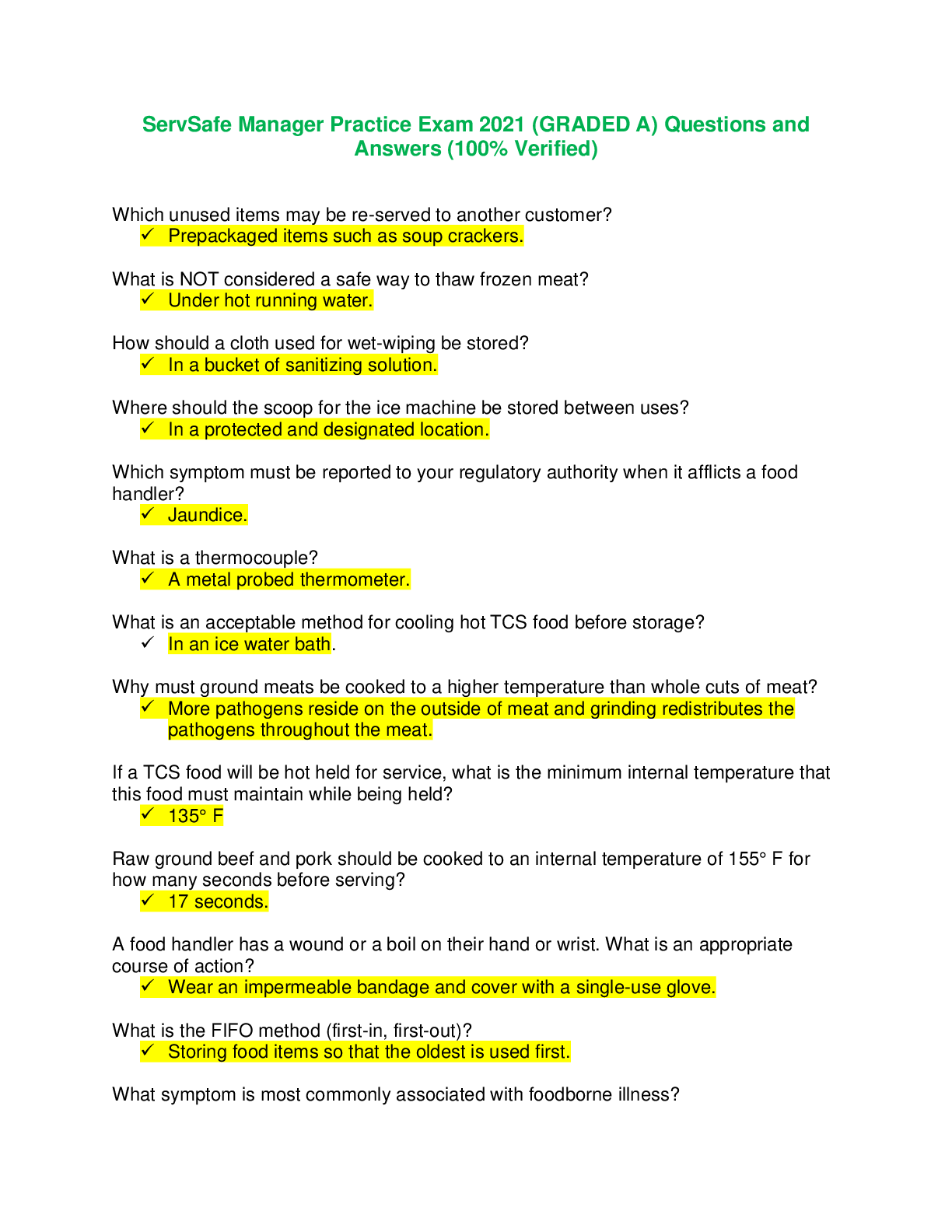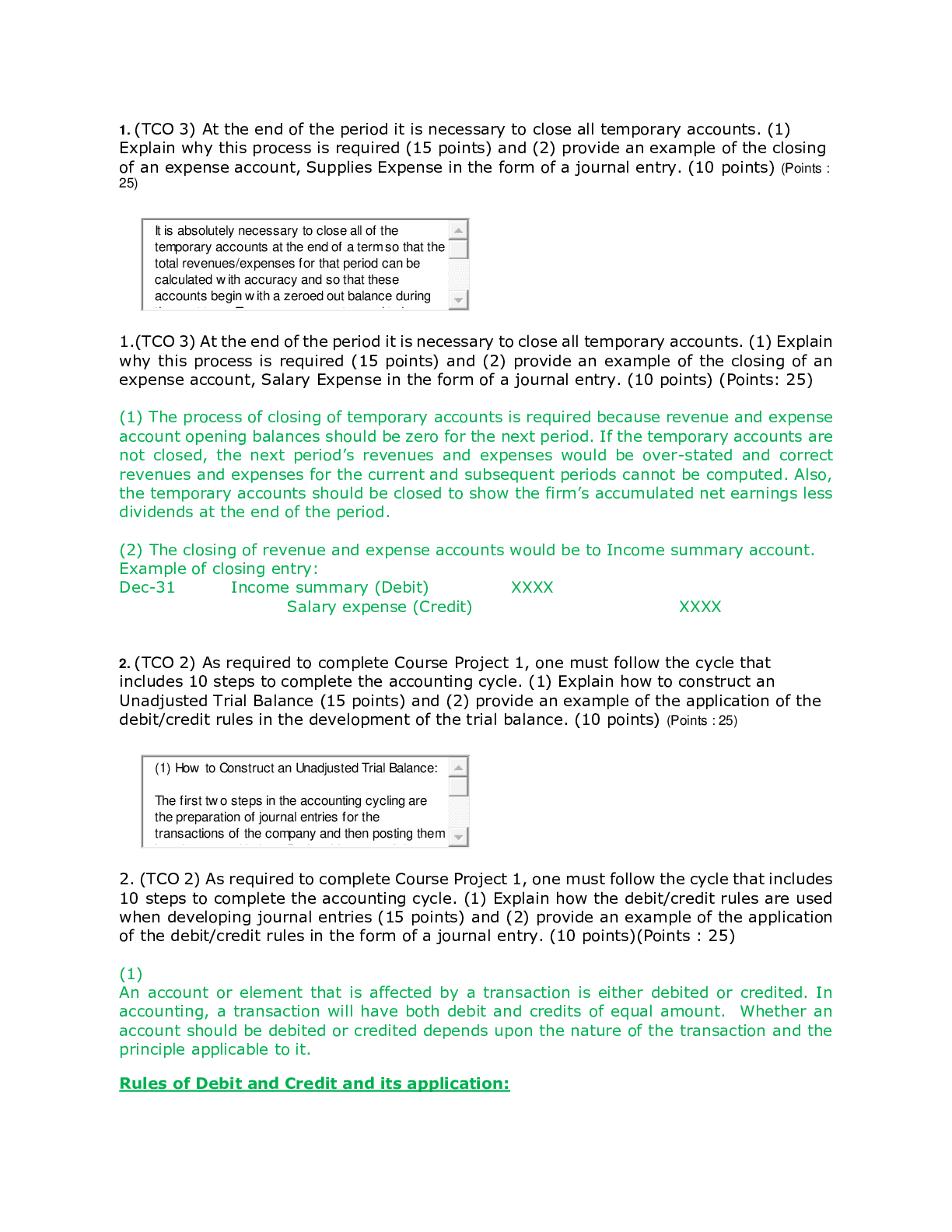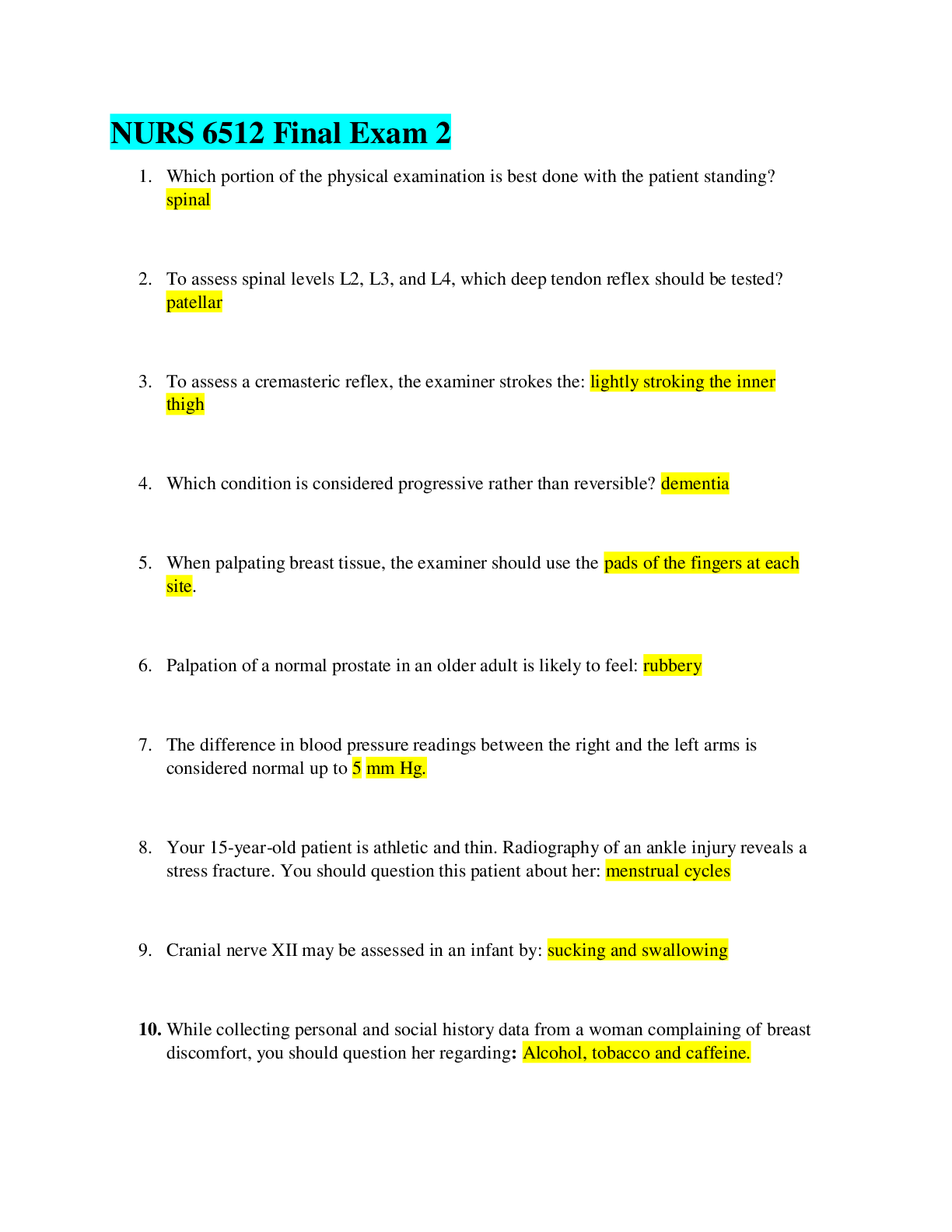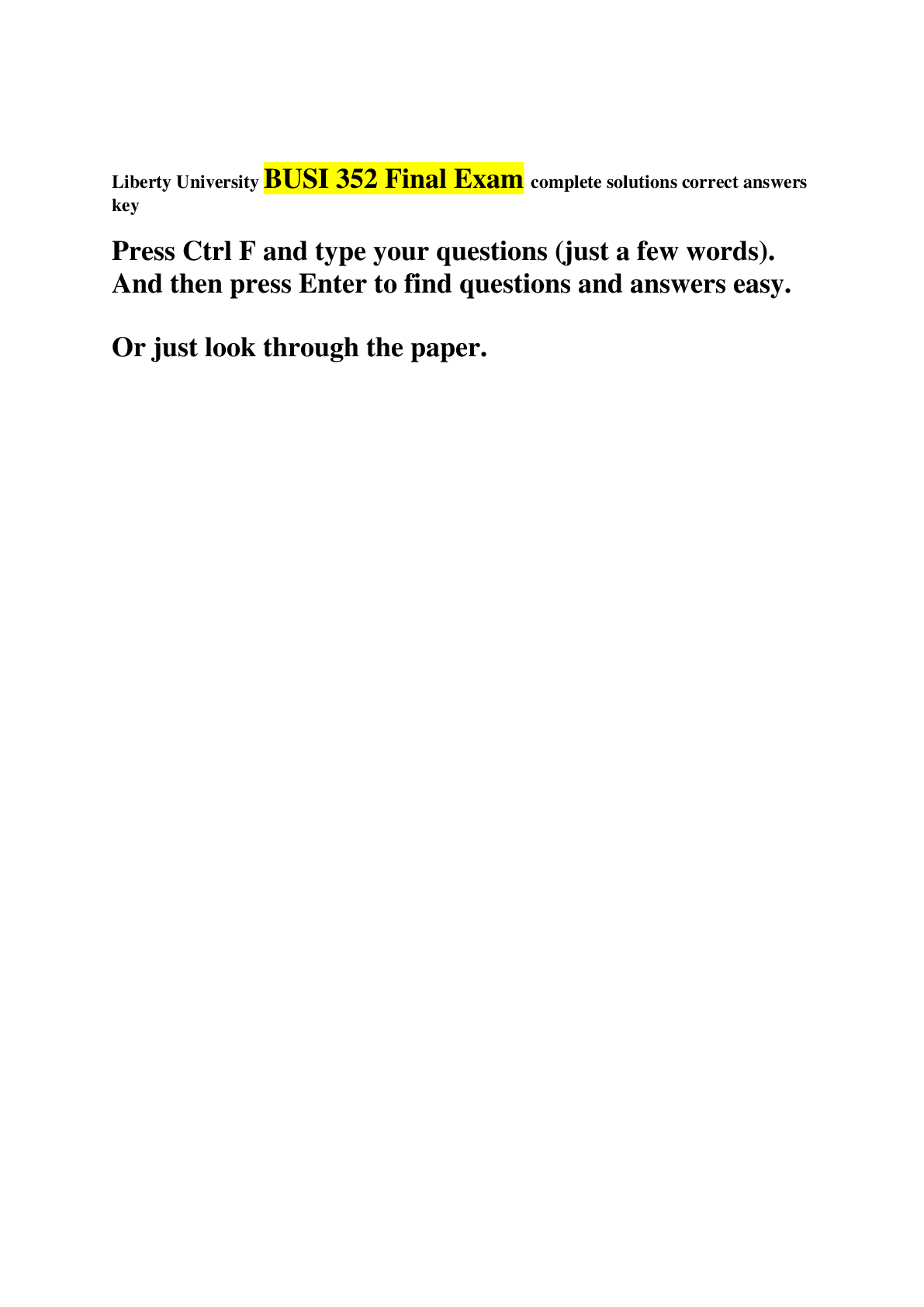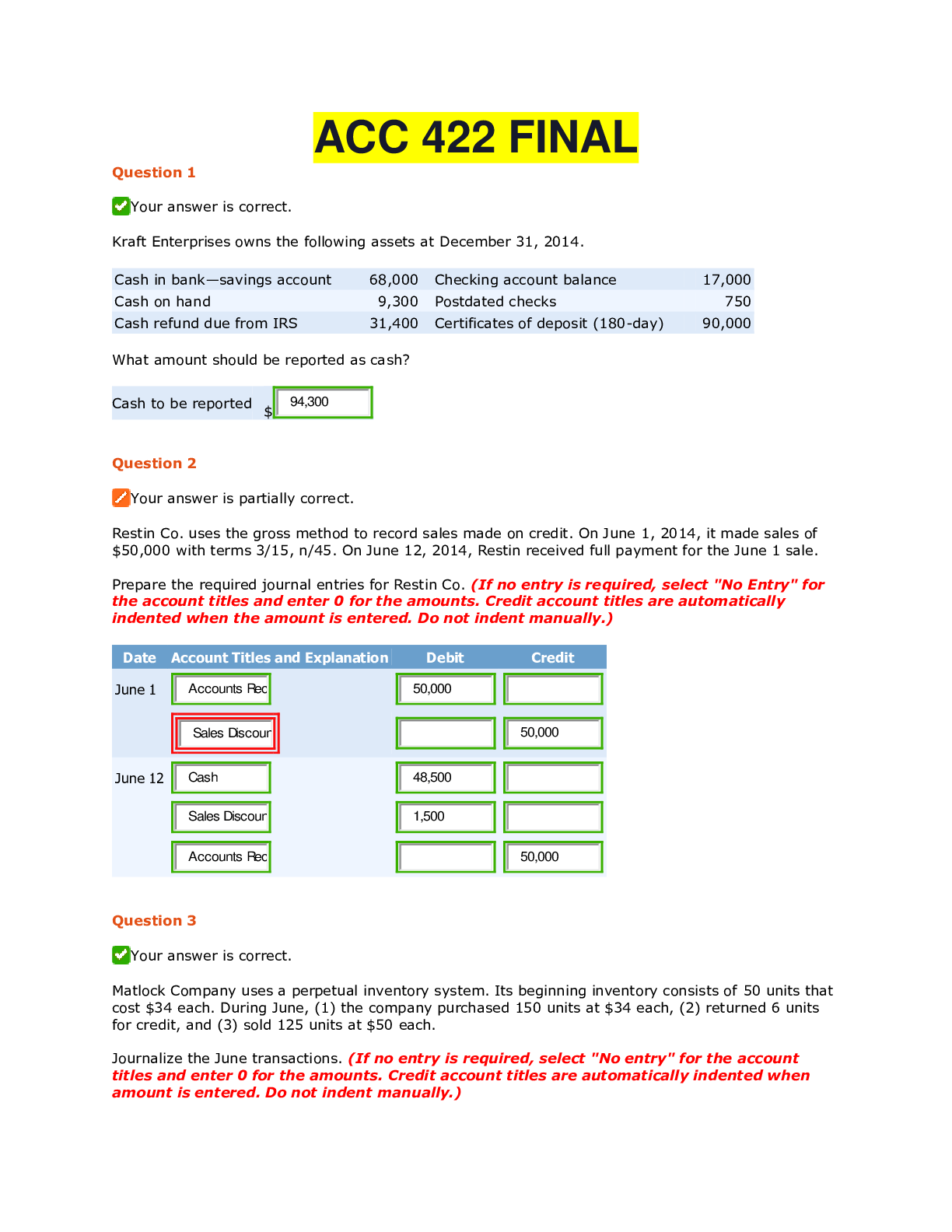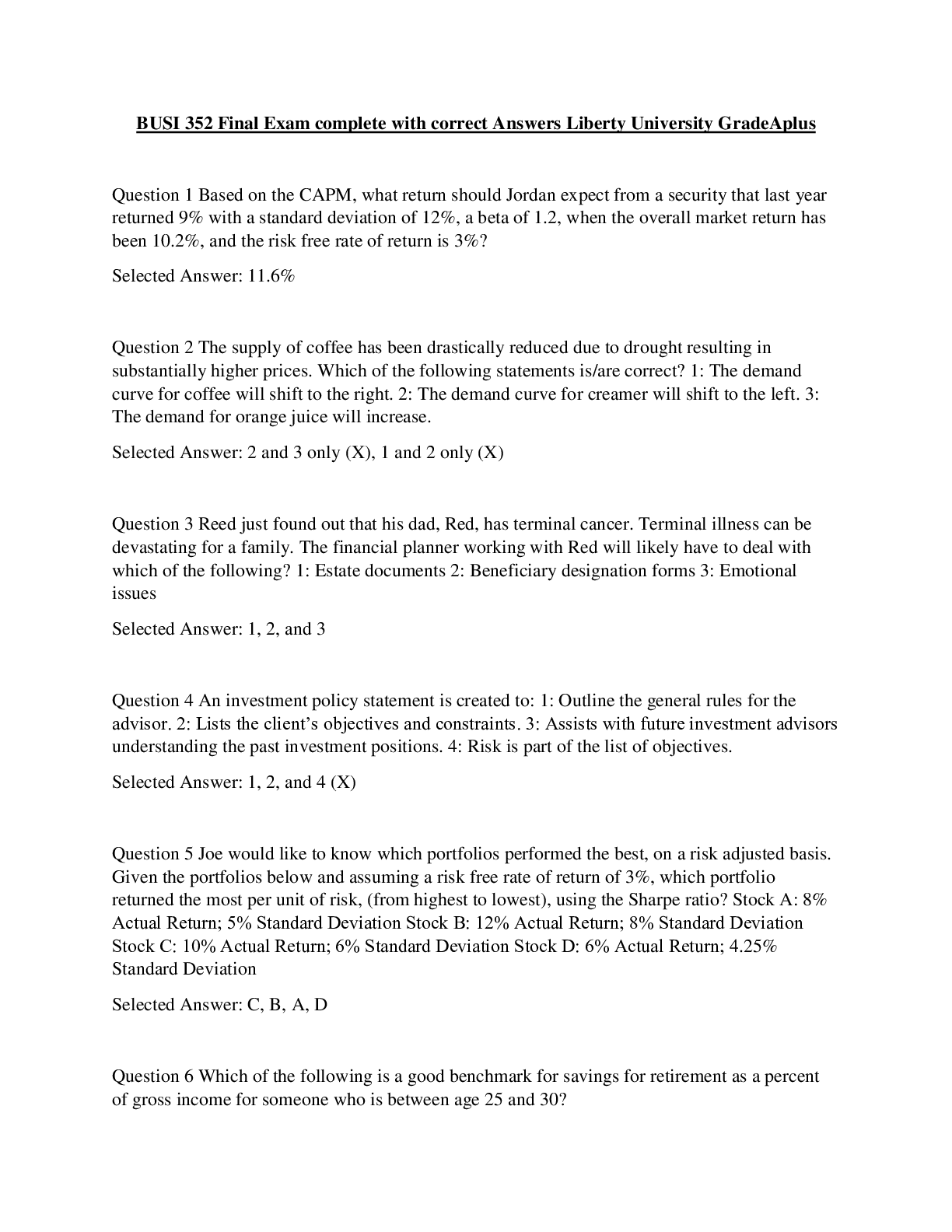Micro Biology > EXAM > BSC 2086 Microbiology Lab/ A&P 2 FINAL EXAM STUDY GUIDE/ (130)- Questions and Answers/ Download To A (All)
BSC 2086 Microbiology Lab/ A&P 2 FINAL EXAM STUDY GUIDE/ (130)- Questions and Answers/ Download To Ace the exams
Document Content and Description Below
FINAL EXAM BSC2086 Chapter 17: Endocrine System 1) What is the main difference between endocrine and exocrine glands? - Exocrine glands have ducts and endocrine glands are ductless 2) What i... s a hormone? - A chemical messenger that is transported by the bloodstream and stimulate physiological responses in cells of another tissue or organ. 3) What is the name given to an organ or tissue that is influenced by a given hormone? - A target organ 4) Name the location, target organ or tissue and principle effects of the following hormones: Follicle-stimulating hormone, growth hormone, antidiuretic hormone, melatonin and calcitonin - FSH – Ovaries, Testes – Female: growth of ovarian follicles and secretion and Male: Sperm Production - Growth hormone - Liver, bone, cartilage, muscle, fat – Widespread tissue growth - Antidiuretic hormone- Kidneys – Water Retention - Melatonin- Brain- May influence mood and sexual maturation - Calcitonin- Bone- Stimulates bone deposition 5) Explain the negative feedback inhibition. - The pituitary stimulates another endocrine gland to secrete its hormone, and that hormone feeds back to the pituitary or hypothalamus and inhibits further secretion of the pituitary hormone. 6) List the three stages of stress. - Alarm Reaction - Resistance - Exhaustion 7) What would be a consequence of defections ADH receptors? - Diabetes Insipidus 8) What are the hormones secreted by the thymus gland and what is the purpose of the thymus? - Thymopoietin and thymosins. - Secretes hormones that regulate development and later activation of T-lymphocytes. 9) What are the differences between endocrine and exocrine glands? Endocrine glands: (internal secretions) - are ductless - release their secretions into the bloodstream - secretions have intracellular effects - alter metabolism - have high density of blood capillaries that serve in picking up and carrying away hormones Exocrine glands: - have ducts - products are secreted through ducts onto an epithelial surface (skin or mucosa of digestive tract) - secretions have extracellular effects, such as the digestion of food 10) Which glands are both endocrine and exocrine? - Liver and pancreas 11) What are the major organs of the endocrine system? - Pineal gland - Hypothalamus - Pituitary gland - Thyroid gland - Thymus - Adrenal gland - Pancreas - Parathyroid glands - Gonad: Testes & Ovaries 12) List the hormones released by the anterior and posterior pituitary gland and their functions. Anterior pituitary hormones: - Follicle-stimulating hormone (FSH): o Secreted by gonadotrope cells o Stimulates production of egg or sperm cell. o Ovaries, testes - Luteinizing hormone (LH): o Secreted by gonadotrope cells o Females- stimulates ovulation and corpus luteum to secrete progesterone and estrogen o Males- stimulates interstitial cells of testes to secrete testosterone. o Target organ-testes & ovaries - Thyroid stimulating hormone (TSH): o Secreted by thyrotropes o stimulates growth of gland o secretion of thyroid hormone (TH). - Adrenocorticotropic hormone (ACTH): o Secreted by corticotrope cells o stimulates adrenal cortex o secretion of glucocorticoids - Prolactin (PRL): o Secreted by pituitary cells (lactotropes) o Mammary glands, testes o Female: milk synthesis o Increased LH sensitivity - GH (Growth Hormone): o Secreted by somatotropes, o Liver, bone, cartilage, muscle, fat. o Widespread tissue growth. Posterior pituitary hormones: - Oxytocin (OT): o Uterus, mammary glands o Labor contractions, milk release o Stimulates the flow of milk from deep in the mammary gland to the nipple. - Antidiuretic hormone (ADH): o Kidneys o Water retention, reduces urine volume o Help prevent dehydration 13) Endocrine diseases - Cushings Syndrome: o Hypersecretion of ACTH by pituitary gland o Excess cortisol - Diabetes Insipidus: o Polyuria- excess amounts of urine o Urine without presence of glucose - Diabetes Mellitus: o Type 1: insulin dependant o Type 2: most common- insulin resistant - Graves Disease: o Thyroid hypertrophy and secretion CHAPTER 18: CIRCULATORY SYSTEM- BLOOD 14) List the function of blood: - Transport: O2, CO2, waste, hormones, and heat - Protection: WBCs, antibodies, and platelets - Regulation: Fluid regulation and buffering 15) If a person with AB- blood is involved in an accident and has had a significant amount of blood loss, which blood type would be safe for them to receive. - O- 16) Name the universal blood donors and recipients, as well as the most common - O- universal donor - AB universal recipient - O+ most common blood type in the US 17) What are the four blood types that form the ABO blood group - A, B, AB, O 18) Erythrocyte disorder: - Polycythemia: an excess of RBC’s - Increased blood volume, pressure and viscosity 19) Anemia: - inadequate erythropoiesis or hemoglobin synthesis 20) The term for the resistance of blood flow: - Viscosity 21) The production of erythrocytes (RBCs) - Erythropoiesis 22) Causes of anemia: Inadequate Erythrocytes - Iron-deficiency Anemia: dietary iron deficiency - Pernicious Anemia: deficiency when the stomach glands fail to produce intrinsic factor, resulting in a deficiency in Vitamin B12 23) Sickle-Cell Anemia: - hereditary hemoglobin defects that occur mostly among African Americans and people of Mediterranean descent - It is caused by a recessive allele that modifies the hemoglobin -Sickled erythrocytes are sticky, they agglutinate (clump together) and block small blood vessels, causing intense pain in oxygen-starved tissues. 24) Types of Leukocytes & their functions: Granulocytes - Neutrophils: o Most abundant o Response in bacterial infection o Functions: phagocytize bacteria, release antimicrobial chemicals o Multi lobed nucleus - Eosinophils: o Response in parasitic infections, allergy reactions, & collagen diseases o Phagocytize antigen-antibody complexes, allergens, and inflammatory chemicals o Nucleus usually has two large lobes connected by a thin strand. - Basophils: o Increase in chicken pox, diabetes mellitus, myxedema, and polycythemia o Secrete histamine o Secretes heparin (anticoagulant) o Nucleus has large U to S shape, typically obscured from view. Agranulocytes - Lymphocytes: o Immune responses o Destroy cancer cells, virus infected cells o Present antigens to activate other cells of immune system o Secrete antibodies o Serve in immune memory - Monocytes: o Largest size leukocyte cell o Increases in viral infections and inflammation o Phagocytize pathogens, dead neutrophils, and debris of dead cells o Present antigens to activate other cells of the immune system. CHAPTER 19: CIRCULARTORY SYSTEM- THE HEART 25) Describe the pathway of blood through the heart. Blood Enters - Superior/Inferior vena cava into right atrium - Tricuspid valve - Right ventricle - Pulmonary valve - Pulmonary trunk - Blood distributed by R & L pulmonary arteries - Lung - Pulmonary vein - Left atrium - Mitral valve - Left ventricle - Aortic valve - Ascending aorta - Organs 26) What are the differences between the pulmonary and systemic circuit? - Pulmonary circuit (right): carries blood to the lungs for gas exchange and returns it to the heart. - Systemic circuit (left): supplies blood to every organ of the body 27) Circulatory System - Heart - Blood vessels - Blood 28) Cardiovascular system: - Heart - Arteries - Veins - Capillaries 29) The heart wall consists of: - Epicardium (visceral pericardium): outer most layer - Myocardium: middle layer, thickest, performs the work of the heart - Endocardium: the inner most layer, contains no adipose tissue 30) Cardiac cycle: - Ventricular filling: during diastole, the ventricles expand and their pressure drops below that of the atria. - Isovolumetric contraction: Atria repolarize, relax and remain diastole for the rest of the cycle - Ventricular ejection: begins when ventricular pressure exceeds arterial pressure and forces the semilunar valves open. - Isovolumetric relaxation: ventricular diastole 31) End-diastolic volume (EDV), Stroke Volume (SV), end- systolic volume (ESV) - EDV-SV=ESV 32) The heart consists of: - Four chambers: 2 superior (left and right atria), 2 inferior (left and right ventricles) - Tricuspid valve (in between right atrium and right ventricle) - Pulmonary valve (right ventricle into pulmonary trunk)- semilunar valves - Mitral (bicuspid) valve (in between left atrium and ventricle) 33) The cardiac conduction system: - (sinoatrial node) SA node fires - Excitation spreads through atrial myocardium - (Atrioventricular node) AV node fires - Excitation spreads down AV bundle - Purkinje fibers distribute excitation through ventricular myocardium 34) Known as the pacemaker of the heart: - Sinoatrial Node 35) Heart disorders: - Myocardial infarction (MI) (heart attack): can be caused by a fatty deposit or blood clot in a coronary artery causing a disruption in blood flow. - Angina: Sense of heaviness or pain in the chest resulting from temporary and reversible ischemia, or deficiency of blood flow to the cardiac muscle. - Coronary Artery Disease: constriction of the coronary arteries usually resulting from an accumulation of lipid deposits that degrade the arterial wall and obstruct the lumen (atherosclerosis). - Heart failure: Left heart failure- pulmonary edema, fluid gets retained in the lungs. Right heart failure- systemic edema- leg/abdominal swelling - Tachycardia: heart rate above 100 bpm - Bradycardia: heart rate below 60 bpm 36) Known as the brain center: - Medulla oblongata 37) Electrolyte imbalances: - Hyperkalemia: myocardium less excitable, HR slow and irregular - Hypokalemia: cells hyperpolarized, requires increased stimulation - Hypercalcemia: decreased HR - Hypocalcemia: increased HR 38) Provides an alternative route that supplies the heart tissue with blood if the primary route becomes obstructed. - Arterial Anastomoses Chapter 20: Circulatory System- Blood Vessels 39) Flow of blood from heart to legs - Heart - Aorta - Descending aorta - Celiac trunk - Common iliac - External/internal iliac - Femoral - Popliteal - Tibial - Fibular - Plantar arch 40) A patient suffering from engorged veins in legs - Varicose veins 41) The wall and arteries are composed of 3 parts: - Tunica interna (intima): inner layer, simple squamous epithelium, exposed to blood - Tunica media: middle layer, thickest layer, smooth muscle, collagen, and some elastic - Tunica externa (tunica adventitia): outermost layer, loose connective tissue with vasa vasorum. 42) Arteries (resistance vessels): - Conducting (elastic) arteries: largest, include aorta, common carotid - Distributing (muscular) arteries: distributes blood to specific organs, femoral and splenic - Resistance (small) arteries: smallest of arteries, arterioles control amount of blood to various organs - Metarterioles: short vessels connect arterioles to capillaries. 43) Most common circulatory route: - Heart - Arteries - Arterioles - Capillaries - Venules - Veins 44) Unit of measurement for blood pressure: - mmHg: millimeters of mercury 45) Three variables that affect peripheral resistance blood flow: - Blood viscosity - Vessel length - Vessel radius 46) Factors that promote venous return to the heart: - Pressure gradient - Gravity - Skeletal muscle pump - Thoracic pump - Cardiac suction 47) The three main ways of blood pressure and blood flow regulation: - Local - Neural - Hormonal 48) Arteriosclerosis: - The increasing stiffness of arteries (hardening of the arteries) 49) Local control: - Tissues regulate their own blood supply - Angiogenesis can occur (generating of new blood vessels) 50) Neural control: - Vasomotor center of the medulla oblongata - Baroreflex: negative feedback response to changes in BP - Chemoreflex: autonomic response to changes in the blood chemistry, especially in pH and concentrations of O2 and CO2 - [CO2] + H2O H2CO3 (carbonic acid) - increased CO2 = increased H2CO3 - decreased CO2 = decreased H2CO3 51) Hormonal control: - Increase blood pressure o Aldosterone: Na+ and water retention by kidneys o Antidiuretic hormone (ADH): Water retention o Epinephrine/norepinephrine: Bind to adrenergic receptors, vasoconstriction o Angiotensin II: potent vasoconstrictor, synthesizes ACE. Hypertension often treated with ACE inhibitors. - Decrease blood pressure o Atrial natriuretic factor: (ANF/ANP) increased urinary sodium excretion, generalized vasodilation o Renin Angiotensin mechanism: angiotensinogen- produced by liver, renin (kidney enzyme released by low BP), Angiotensin I- ACE (angiotensin-converting enzyme in lungs) ACE inhibitors block this enzyme lowering BP. 52) Circulatory shock: - Hypovolemic shock: Most common form, produced by loss of blood volume as a result of hemorrhage, trauma, bleeding ulcers, burns, or dehydration. - Obstructed venous return shock: occurs when any object, such as growing tumor or aneurysm, compressed a vein and impedes its blood flow. - Venous pooling (vascular) shock: occurs when the body has a normal total blood volume, but too much of it accumulates in the lower body. Can be caused by long periods of standing or sitting - Neurogenic shock: results from sudden loss of vasomotor tone, allowing the vessels to dilate. - Septic shock: occurs when bacterial toxins trigger vasodilation and increased capillary permeability. - Anaphylactic shock: results from exposure to an antigen to which a person is allergic, such as bee venom. - Cardiogenic shock: inadequate pumping of heart (MI) 53) Disorders/Conditions: - Hypertension: BP higher than 140/90 - Hypotension: BP lower than 90/60 - Hypoxemia: blood O2 deficiency - Hypercapnia: excess CO2 - Acidosis: low blood pH - Transient ischemic attacks (TIA): dizziness, loss of vision, weakness, paralysis, headache or aphasia. Often early warning of impending stroke - Cerebral vascular accident (CVA): Stroke. Brain infarction caused by ischemia. CHAPTER 21: LYMPHATIC SYSTEM 54) Functions of the lymphatic system: - Fluid recovery - Immunity - Lipid reabsorption 55) Lymphatic route from the tissue fluid back to the blood stream: - Lymphatic capillaries - Collecting vessels - Lymphatic trunk - Collecting ducts - Subclavian veins 56) A man is bitten by a snake and is administered an anti-venom. What type of immunity is this: - Artificial Passive Immunity: temporary immunity from injection of immune serum obtained from another person or from animals that have antibodies against a certain pathogen. 57) Natural Active immunity: - Created by one’s own body as a result of natural exposure 58) Natural Passive immunity: - acquiring temporary immunity from antibodies created by another person - Example: placenta to fetus, infant ingesting breast milk 59) Artificial Active immunity: - Created by one’s own body as a result of a vaccination - Example: chicken pox vaccine. 60) Humoral immunity - Provided by plasma cells - Antibody mediated (B Cells) 61) Cellular Immunity: - Cell mediated (T cells) 62) The cardinal signs of inflammation: - Redness (erythema) - Swelling (edema) - Heat - Pain 63) The lines of defense: - First line of defense: Skin and mucous membrane - Second line of defense: leukocytes and macrophages - Third line of defense: mediated by the immune system 64) Lymphatic Cells - Natural killer Cells (NK): responsible for immune surveillance - T Lymphocytes: mature in thymus - B Lymphocytes: activation causes proliferation and differentiation into plasma cells that produce antibodies - Antigen presenting cells: o Macrophages: from monocytes o Dendritic cells: in epidermis, mucous membrane and lymphatic organs) o Reticular cells: contribute to stroma of lymph organs 65) Lymphatic Organs: Primary Organs: - Red bone marrow and thymus - site where T and B cells become immunocompetent Secondary Organs: - lymph nodes, tonsils, and spleen - immunocompetent cells populate these tissues 66) Five classes of antibodies: - IgA: in plasma; mucous salvia, tears, milk, intestinal secretions, prevents adherence to epithelia - IgD: B cell membrane antigen receptor - IgE: on mast cells; stimulates release of histamines, attracts eosinophils; immediate hypersensitivity reactions - IgG: 80% circulating, crosses the placenta to fetus, 2 immune response - IgM: 10% in plasma, 1 immune response, agglutination 67) Disorders/Conditions: - Acquired immunodeficiency syndrome (AIDS) - Human immunodeficiency virus (HIV) - Severe combined immunodeficiency disease (SCID) - Hodgkin disease: lymph node malignancy - Splenomegaly: enlargement of the spleen CHAPTER 22: RESPIRATORY SYSTEM 68) The mechanism of debris removal - Mucociliary escalator 69) The pathway of gas exchange: - Respiratory Bronchiole - Alveolar duct - Atrium - Alveolus 70) Respiratory system functions: - Gas exchange: O2 and CO2 exchange between blood and air - Communication: serves for speech and other vocalization - Olfaction: provides sense of smell - Acid-base balance: helps control pH of body fluids. - Blood pressure regulation: lungs carry out a step in synthesizing angiotensin II - Blood and lymph flow: breathing creates pressure gradients between the thorax and abdomen to promote the flow of lymph and venous blood - Blood filtration: the lungs filter small blood clots from the bloodstream and dissolve them. - Expulsion of abdominal contents: breath-holding helps to expel abdominal contents during urination, defecation and child birth. 71) Principal organs of the respiratory system: - Nose - Pharynx - Larynx - Trachea - Bronchi - Lungs 72) Airflow in the lungs - Bronchi bronchioles alveoli 73) Conducting division: - Passages for airflow, Nostril to bronchioles 74) Respiratory division: - Distal gas exchange regions- alveoli 75) Parts of the respiratory tract: Upper respiratory tract: - organs in head and neck, nose through larynx Lower respiratory tract: - organs of thorax, trachea through lungs 76) Alveoli stay inflated by: - Surfactant 77) Pleurae and Pleural fluid: - Visceral pleurae- on lungs - Parietal pleurae- lines rib cage - Pleural cavity: space between pleurae, lubricated with fluid - Functions: reduce friction, create pressure gradient, compartmentalization 78) Gas exchange only occurs in the alveolar membrane 79) O2 travels by: - Oxyhemoglobin 80) Rate and depth of breathing adjusted to maintain levels of: - pH - Pco2 - Po2 81) Respiratory acidosis: (person who consumed alcohol decreased resp., heart rate: 10 bpm) - pH less than 7.35 - caused by failure of pulmonary ventilation - decreased respiratory rate - increased concentration of CO2 in the blood 82) Respiratory alkalosis: - pH greater than 7.45 - caused by hyperventilation 83) Respiratory volumes: - Tidal Volume (TV): volume of air in one quiet breath - Inspiratory reserve volume (IRV): air in excess of tidal inspiration that can be inhaled with maximum effort - Expiratory reserve volume (ERV): air in excess of tidal expiration that can be exhaled with maximum effort - Residual Volume (RV): Keeps alveoli inflated, air remaining in lungs after maximum expiration. Never able to remove from lungs 84) Respiratory capacities: - Vital capacity (VC): ERV + TV + IRV = VC - Inspiratory capacity (IC): TV + IRV = IC - Functional residual capacity (FRC): RV + ERV =FRC - Total lung capacity (TLC): RV + VC = TLC 85) Alveolar ventilation rate: - (volume of air inhaled – Dead space) x resp. rate 86) Diseases/conditions: - Hypoxia: is often marked by cyanosis ( blueness of the skin) - Hypoxemic hypoxia: low Po2, usually due to inadequate pulmonary gas exchange - Ischemic hypoxia: inadequate circulation of the blood - Anemic hypoxia: due to anemia and the resulting inability of the blood to carry adequate oxygen - Histotoxic hypoxia: occurs when metabolic poison such as cyanide prevents tissues from using the oxygen delivered to them - Chronic obstructive pulmonary disease (COPD): o Chronic bronchitis: persistent inflammation of the lower respiratory tract, cilia immobilized, goblets enlarge and produce excess mucous o Emphysema: alveolar walls breakdown, lungs fibrotic and less elastic, air passages collapse. o Asthmas: allergen triggers histamine release, intense bronchoconstriction - Lung cancer o #1 cancer in US, most important cause is smoking. o Squamous-cell carcinoma: Most common, begins with transformation of bronchial epithelium into stratified squamous. o Adenocarcinoma: originates in mucous glands of lamina propria o Small-Cell (oat cell) carcinoma: least common, most dangerous, originates in primary bronchi, invades mediastinum, metastasizes quickly. - Infant Respiratory Distress Syndrome: lack of alveolar cells that aren’t producing enough surfactant. CHAPTER 23: URINARY SYSTEM 87) Functions of the kidneys - Filter the blood plasma - Regulates osmolarity of body fluids, blood volume, BP - Secretes: renin and erythropoietin - Detoxifies: free radicals and drugs 88) Excretion: Separation of wastes from body fluids and eliminating them by four systems: - Respiratory: CO2 - Integumentary: water, salts, lactic acid, urea - Digestive: water, salts, CO2, lipids, bile, pigments, cholesterol - Urinary: many metabolic wastes, toxins, drugs, hormones, salts, H+ and water 89) Anatomy of Kidney: - 2 kidneys, two ureters, 1 urethra - Retroperitoneal at the level of T12 to L3 - Right kidney sits slightly lower because of the liver. - CT coverings: o Renal fascia: binds to abdominal wall o Adipose capsule: cushions kidney o Renal capsule: located below renal fascia, encloses kidney like cellophane wrap - Renal cortex: outer layer - Renal Medulla: renal columns, pyramids- papilla, majority of collecting ducts found here. 90) Renal Corpuscle: - Consist of 2 components: Glomerular capsule (parietal- outer, visceral- inner) and Glomerulus 91) Renal Tubule: is a duct that leads away from the glomerular capsule and ends at the tip of a medullary pyramid. It’s divided into four regions. - Proximal convoluted tubule (PCT): arises from the glomerular capsule - Nephron Loop: a long U-shaped portion of the renal tubule. It begins where the PCT straightens out and dips towards the medulla, forming the descending limb (water permeable). At its deep end, the loop turns and forms the ascending limb (active transport of salts). - Distal convoluted tubule (DCT): begins shortly after the ascending limb reenters the cortex - Collecting duct: receives fluid from the DCTs of several nephrons as it passes back into the medulla. 92) The flow of fluid from the glomerular filtrate is formed to the point where urine leaves the body. - Glomerular capsule PCT Nephron loop DCT Collecting duct papillary duct minor calyx major calyx renal pelvis ureter urinary bladder urethra 93) Filtration pressure: Blood hydrostatic pressure (BHP) 60 mm Hg out Colloid osmotic pressure (COP) - 32 mm Hg in Capsular pressure (CP) - 18 mm Hg in Net Filtration pressure (NFP) 10 mm Hg out 94) Effects of GFR abnormalities: - GFR, urine output rises dehydration, electrolyte depletion - GFR wastes reabsorbed (azotemia possible) 95) Glomerular Filtration Rate (GFR) controlled by adjusting glomerular blood pressure by 3 mechanisms: - Autoregulation - Sympathetic control - Hormonal mechanism: renin and angiotensin 96) Negative Feedback Control of GFR 1. High GFR 2. Rapid flow of filtrate in renal tubules 3. Sensed by macula densa 4. Paracrine secretion 5. Constriction of afferent arteriole 6. Reduced GFR 97) Formation of urine - Filtration: Glomerular - Reabsorption: Tubular - Secretion: Tubular 98) Basic stages of Urine Formation 1. Glomerular Filtration: creates a plasma like filtrate of the blood 2. Tubular reabsorption: removes useful solutes from the filtrate, returns them to the blood 3. Tubular secretion: removes additional wastes from blood, adds them to the filtrate 4. Water conservation: Removes water from the urine and returns it to blood; concentrates wastes. CHAPTER 24: WATER, ELECTROLYTE, AND ACID-BASE BALANCE 99) Three types of homeostatic balance: - Water balance: avg. daily water intake and loss are equal - Electrolyte balance: the amount of electrolytes absorbed by the small intestine balance with the amount lost from the body, usually urine - Acid-base balance: the body rids itself of acid (H+) at a rate that balances metabolic production. 100) Major fluid compartments: - Intracellular fluid (ICF): 65% (in the cells) - Extracellular fluid (ECF): 35% (outside the cells) - Tissue (interstitial) fluid: 25% - Blood plasma & lymphatic fluid: 8% - Transcellular fluid: 2% 101) Functions of electrolytes: - Maintain water balance - Assist in muscle contractions and relaxations - Helps in transmitting nerve impulses 102) Electrolyte Major and minor cations: - Major o Na+, K+, Ca2+ and H+ - Minor o Cl-, HCO3- (bicarbonate), and PO 3- 103) Imbalances: - Hyperkalemia: potassium levels greater than 5.5 mEq/L - Hypokalemia: potassium levels below 3.5 mEq/L - Hypernatremia: plasma sodium greater than 145 mEq/L - Hyponatremia: plasma sodium below 130 mEq/L - Hyperchloremia: chlorine levels greater than 105 mEq/L - Hypochloremia: chlorine levels below 95 mEq/L - Hypercalcemia: calcium levels greater than 5.8 mEq/L - Hypocalcemia: calcium levels below 4.5 mEq/L - Hypermagnesemia: magnesium levels above 2.0 mEq/L - Hypomagnesemia: magnesium levels below 1.5 mEq/L 104) Blood pH levels: - Acidosis: blood pH below 7.35 - Alkalosis: blood pH above 7.45 105) A person climbing a mountain would suffer from acidosis. CHAPTER 25: DIGESTIVE SYSTEM 106) Includes: - Mouth - Pharynx - Esophagus - Stomach - Small and Large intestines Accessary organs consist of: - Teeth - Tongue - Salivary glands - Liver - Gallbladder - pancreas 107) Starch and fat digestion begins in - Saliva 108) Regional surface of the stomach: - Cardiac region: just inside the cardiac orifice - Fundus: domed portion superior to esophageal - Pyloric region: narrow inferior end (pylorus- opening to duodenum) 109) Digestive system tissue layers: (in order from the inner most to the outer surface) - Mucosa o Epithelium o Lamina propria o Muscularis mucosae - Submucosa - Muscularis extern o Inner circular layer o Outer longitudinal layer - Serosa o Areolar tissue o Mesothelium 110) The pathway of food from the mouth to the anus: 1. Mouth 2. Pharynx 3. Esophagus 4. Cardiac spincher 5. Stomach 6. Pyloric spincher 7. Duodenum- SI 8. Jejunum-SI 9. Ilium-SI 10. Ileocecal valve 11. Ascending colon 12. Transverse colon 13. Descending colon 14. Segmoid colon 15. Rectum 16. Anus 111) Forms of Digestion: - Carbohydrate (starch) digestion: begin- mouth, end- doud of SI, accessory- salivary gland - Protein digestion: begin-stomach, end doud of SI, accessory: pancreas - Fat digestion: begin- doud of SI, end- doud of SI, accessory- gallbladder and liver 112) Digestive Enzymes: - Pepsin (Protein digestion) - Gastric lipase - Hydrochloric acid - Salivary amylase - Lysozyme - Electrolytes - IgA - Lingual lipase CHAPTER 26: NUTRITION AND METABOLISM 113) Three principle forms of carbohydrate: - Monosaccharides: glucose, fructose, galatose - Disaccharides: sucrose, maltose, lactose - Polysaccharides: starch, cellulose 114) Three functions of lipids: - Structural - Chemical precursor - Protective and insulating functions 115) A newborn is exclusively fed fat free milk for initial 6 months. Is this a good diet option? - No, because fat-free milk does not contain lipids. Infants require lipids as part of the development of the nervous system affecting the cellular structure. 116) Most common vitamin deficiency: - Vitamin A: causes blindness 117) Vitamins: - Water soluble: Vitamin C, B Complex vitamins - Fat soluble: Vitamins A, D, K, A and E 118) Basal Metabolic Rate (BMR) - the rate at which our bodies use energy while at rest in order to maintain the body systems functioning. CHAPTER 27: MALE REPRODUCTIVE SYSTEM 119) Primary sex organs: - Testes (produce gametes) 120) Secondary sex organs: - Ducts, glands, penis 121) Sex Differentiation: - Mesonephric ducts develop into male reproductive system 122) External genitals of both sexes begin as: - Genital tubercle o Becomes glans of penis or o Clitoris (female) - Pair of urogenital folds o Enclose urethra of male or o Form labia minora- female - Pair of labioscrotal folds o Scrotum- male or o Labia majora- female 123) Cryptorchidism: undescended testes 124) Male urethra consists of 3 regions: - Prostatic - Membranous - Penile (spongy) 125) Gonadotropin: - Hormones that stimulate the gonads (FSH & LH) - Secreted from the pituitary gland 126) Brain- testicular axis - Hypothalamus produces GnRH - Stimulates anterior pituitary to secret LH & FSH - LH: stimulates interstitial cells to produce testosterone - FSH: stimulates sustentacular cells to secrete androgen-binding protein that interacts with testosterone to stimulate spermatogenesis 127) Spermatogenesis - Diploid cells (spermatogonium) in the seminiferous tubules undergo mitosis to produce two diploid cells called secondary spermatocytes. These 2 cells then undergo meiosis to produce 4 haploid cells. These haploid cells mature into 4 haploid sperm cells (spermatozoa) 128) Pathway of sperm: - Efferent ducts - Duct of epididymis - Ductus deferens - Ejaculatory duct 129) Gubernaculum - Cordlike structure containing muscle - extends from the gonad to abdominopelvic floor - guides testes to the scrotum [Show More]
Last updated: 2 years ago
Preview 1 out of 40 pages

Buy this document to get the full access instantly
Instant Download Access after purchase
Buy NowInstant download
We Accept:

Reviews( 0 )
$13.00
Can't find what you want? Try our AI powered Search
Document information
Connected school, study & course
About the document
Uploaded On
May 30, 2021
Number of pages
40
Written in
Additional information
This document has been written for:
Uploaded
May 30, 2021
Downloads
0
Views
60

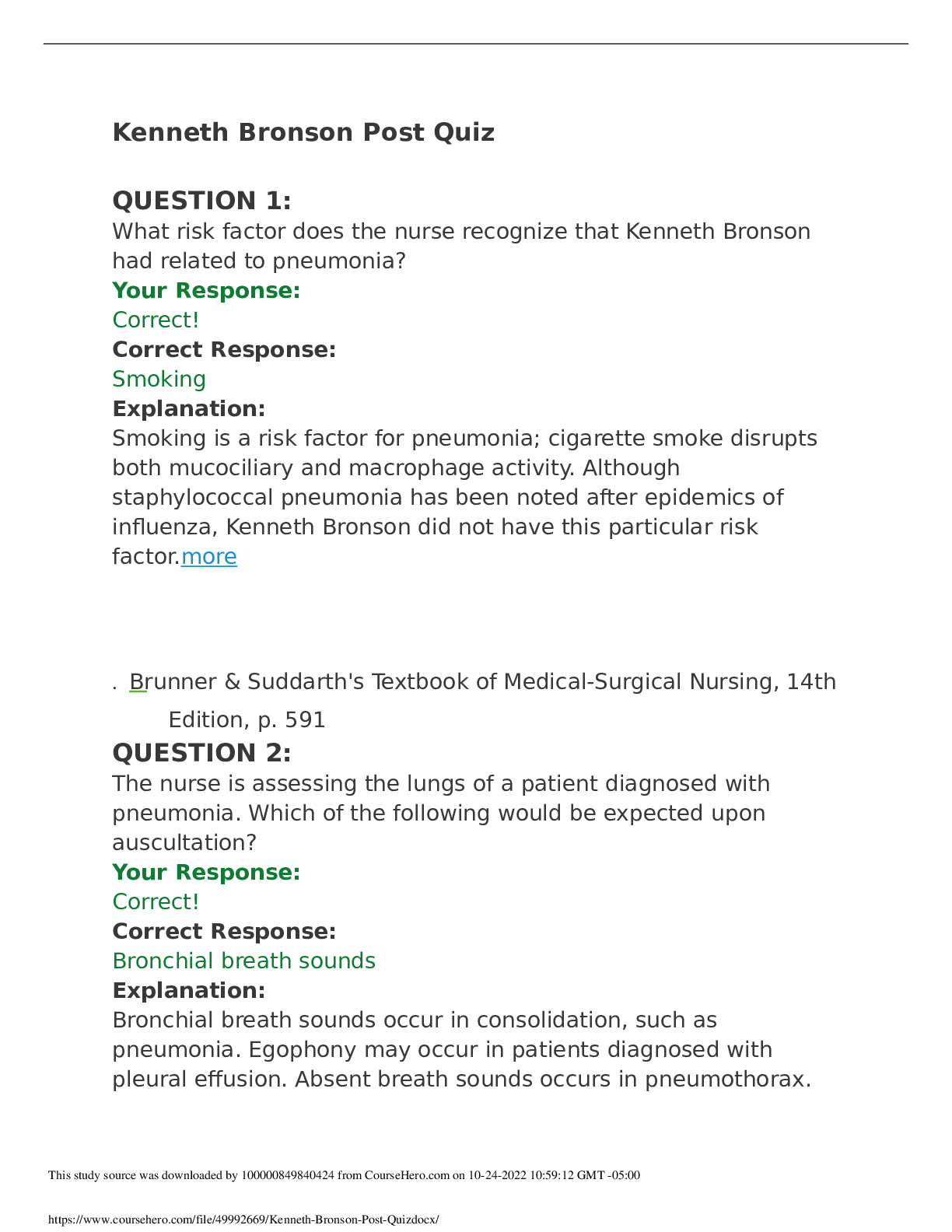



 Questions and Answers 100% VERIFIED.png)
 Questions and Answers 100% correct Solutions.png)



